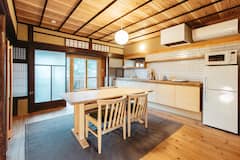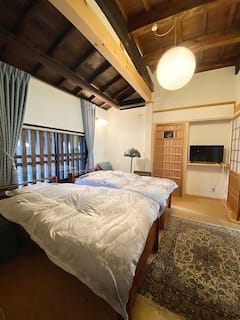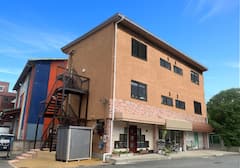Nara, the capital city of Nara Prefecture, is located in Japan’s Kansai region. Tourism in the beautiful and historic city entices many travelers from around the world throughout the year. The city has many shrines, temples and ruins such as the Tōdai-ji, Kōfuku-ji, Kasuga Shrine, Heijō Palace and more. Nara is a compact city with historical charm and it has several UNESCO World Heritage Sites such as Kasuga Grand Shrine (a Shinto Shrine), Kasugayama Primeval Forest, Yakushi-ji (a Buddhist temple) and more. Nara is also popular for some hidden caves, some with underground waterfalls. The Fudokutsu Cave in Nara’s Kawakami-mura is a great place to visit, where you will hear the sound of rushing water from many directions. Due to its past as the first permanent capital, Nara has many historic treasures, which includes some of the largest and the oldest temples in Japan. Nara is also less than an hour from Osaka and Kyoto, which makes it a perfect weekend getaway. Check out the top 10 hidden spots in Nara worth exploring.
1. Yoshikien Garden / Nara City

This beautiful Japanese garden is located on the banks of the Yoshiki River. This ground is the place where priests’ residences of Kohfukuji Temple were present before, but now it has been turned to this classical garden. Located next to Nara Park, the plan to build many tourist accommodations in this park may progress a lot by the year 2020. The main building is not open to tourists for the time being, but the cherry blossoms which grow around the pond and the flowers, which are used for tea ceremonies, are for public display. You can also see the garden of tea flowers, where you will find various types like Yamabuki, flower-water tree, hydrangeas, and Higanbana. Tourists will enjoy spending quality time in this garden, which is away from the hustle and bustle of the city life.
Yoshikien Garden
Address: 60-1 Noboriojicho, Nara, Nara Prefecture 630-8213
2. Mysterious pyramids of Nara
Nara Pyramid, which is also known as the Head Tower, is located a kilometer (0.6 miles) south of Todaiji Namdaemun. The excavation of this site, which started in 1986, took 12 years to complete. Before the excavation, this site was a children’s playground. Nara Pyramid is said to be 32 meters (104.96 feet) in length and 10 meters (32.8 feet) in height. The architecture of this building comprises an unknown pyramidal structure, which is not common in Japan. It also has seven staircase-shaped stone mounds. It is believed to be a mysterious burial site after Chinese monk Genkyo died in fear of the evil spirit of Fujiwara Hirotsugu. Tourists can visit this place without any reservation, after taking a tour guidance at Hotel Wellness Asukaji.
Nara Pyramid
Address: Nara City, Takahata Cho 921
3. Yata-dera Temple
Yata-dera temple, formal name is Yatasan Kongousenji Temple, is located in the middle of Yatayama in Yata-kyuryo Hills, which is 3.5km (2.1 miles) west from the castle town of Yamato-koriyama. The 1300-year-old temple was built in the Nara Era by Prince Oama, who was later known as Emperor Tenmu. The temple house is the oldest Enmei Jizo Bosatsu (Kshitigarbha) Statue in Japan. This temple has been planting hydrangea flowers since 1965. Hydrangea, or ‘ajisai’ in Japanese, is native to Japan and this flower has been cultivated since the Nara Era. This temple has about 10,000 varieties of hydrangea flowers from 60 different species. Some varieties bloom in May while the others in September. However, this temple is very popular among tourists visiting Nara in the months of June and July.
Yata-dera Temple
Address: 3549 Yatacho, Yamatokoriyama-shi, Nara-ken 639-1058
Website: Yata-dera Temple
You might be interested in these Airbnbs!
4. Takatori Castle Ruins / Takatori Town
Takatori Castle Ruins is the largest mountain castle in Japan among the three major Oyama castles. It was built on top of Mount Takatori in the year 1332 and it comprises of towers, turrets, gates, bridges, stone walls, earthen walls and moats. The magnificent stone wall looks like a beautiful shrine and it was seen in the animated movie Laputa: Castle in the Sky. Over the centuries, this castle was ruled by 4 different families and 14 lords. The castle was abandoned in 1873 and since then, a dense forest has reclaimed many of its parts. Many regions of the ruins are now inaccessible and hidden by the undergrowth. Some large structures and the trail leading to the are maintained by the town of Takatori. The remote location of the ruins makes it less popular among tourists.
Tsubosakayama on the Kintetsu Yoshino Line is the nearest train station to the ruins. You’ll have to take a bus that runs from the train station to Tsubosaka Temple. From here, you’ll have to take a 3 km (1.86-mile) hike to reach the ruins. If you like hiking, you can also take the 11-km (6.83-mile) train from Tsubosakayama Station via the town of Takatori. You can also rent a bicycle if you don’t like walking.
Takatori Castle Ruins
Website: Takatori Castle Ruins
5. Daruma Temple / Oji

This Buddhist temple is located in Kitakatsuragi and it was founded in 613. This temple is located along National Highway 168 and it was built on an ancient tomb during the second half of the 6th century. It is situated 800 meters (2624 feet) south of JR Kansai mainline. The main hall of the temple includes a wooden statue of Prince Shotoku who is seen wearing a crown and holding a scepter in his hand. The temple also has a wooden Senju Kanon statue and its presence attracts thousands of tourists to this temple throughout the year. It is believed that this statue originally had 500 hands, but now it consists of only 392 hands. You can also see eyes in all the palms of this statue. To the northeast of the main hall is a statue of Prince Shotoku’s pet dog. The statue of the dog in white has now become the official mascot of Oji Town.
Daruma Temple
Address: 2 - 1 - 40 Honcho Honocho Ozone cho, Kita Katsuragi Gun, Nara Prefecture 636 - 0012
Website: Daruma Temple
6. Matabei Cherry / Uda City
Uda city, which is located in the Nara district, is the home to Matabei Cherry tree. This magnificent weeping cherry blossom tree is believed to be about 300 years old. The cherry tree is surrounded by many peach trees. The views are majestic when both blossom together. This tree is named after a local samurai who later became a monk. This samurai’s house is believed to be in this area and he is also believed to have planted this beautiful tree, which now stands 13 meters (42 feet) high. The cherry blooms beautifully from early to mid-April and each year, more than 50,000 visitors come to see the tree.
You can take the Kintetsu Osaka Line to Haibara Station from where you have to take the Nara Kotsu Bus bound for Ouda. You have to get down at Ouda High School and from here, you can reach the tree within a 15-minute walk. You can take Japan National Route 166 to reach this place in a car. Parking facilities are available at a fee.
Matabei Cherry
Address: Oudahongo, Uda, Nara Prefecture 633-2156
Website: Matabei Cherry
7. Abe Monju-in Temple / Sakurai City
This Buddhist temple is located in the Abe area of Sakurai City. Abe-Monju-in Temple dates back to the 7th century and it is one of the oldest Buddhist temples in the country. Abe-Monju-in Temple has been engaged in Kito (prayers and practices) to grant believers wisdom and good fortune with the divine power of Buddhas. The statue of Monju Bosatsu, or the Buddha of wisdom, is enshrined in the main hall and it was carved by Kaikei, a prominent Japanese sculptor in the country during the 13th century. The statue of the god sitting on a lion is 7 meters (22.96 feet) tall. Monju Bosatsu is also holding a raised sword, which represents cutting away ignorance.
You can visit the Ukimi-do Hall, also called Nakamaro-do, which enshrines well-known historical figures such as Abe-no-Nakamaro and Abe-no-Seimei, both of them were born in this temple. People in this temple worship Benzaiten, a Goddess that brings luck. This hall also exhibits many temple treasures.
Abe Monju-in
Address: 645 Sakurai City Nara Prefecture 633-0045
Website: Abe Monju-in Temple
8. Katsuragi Kodo Path / Gosho-shi
Katsuragi Kodo Path is an ancient road that runs through Katsuragi and along the base of Mount Katsuragi and Mount Kongo. This path offers hikers an opportunity to explore and traverse historical shrines and temples that come along the way. It was once the domain of the powerful Katsuragi clan but it now offers a beautiful scene to hikers throughout the year. Mount Katsuragi is famous for beautiful pink azaleas in late spring and red amaryllis flowers in autumn. Apart from the picturesque beauty, the walk also offers travelers an insight into the past of the region with historical remnants that date back to the Yayoi period. Some parts of the path are lined with Jizo statues. This Buddhist deity is well-known in Japan as the protector of travelers and children. It is believed that these Jizo statues always watch over travelers as they endure the journey.
It takes about two hours to walk the path from Mount Katsuragi and Kamoyamaguchi Shrine, through small villages and farmlands to Takagamojinja Shrine. This shrine dates back to the Muromachi period and has beautiful gardens with primroses in spring and irises in mid-summer. From here, you can continue 8 km (4.97 miles) south to Gojo, a beautiful town known for its historic townscape.
Katsuragi Kodo Path
Address: Kamogami, Gose
Website: Katsuragi Kodo Path
9. Mitarai Valley / Tenkawa Village
The 4-meter (13-feet) long Mitarai valley lies at the place where Sanjogawa River and the Ten-no-gawa River in the Nara Prefecture flow together. Mitarai Valley is an amazing hotspot in the Tenkawa village, where tourists can enjoy hiking, plan a BBQ night by the riverside, or have a relaxing time during summers. This place remains very busy and the roads leading to this place experience heavy traffic during the weekends each summer. A clean toilet and a free parking lot are available in this place for guests’ convenience. Mitarai Valley is about a three-hour journey from Nara. You can also stay at the nearby hot spring town of Dorogawa Onsen during your visit to this valley. You’ll have to take a train to Shimoichiguchi Station and then a bus to Dorogawa. There are many narrow mountain roads along the route to this place and it is recommended to reserve cottages beforehand during the summer season.
Mitarai Valley
Address: Kitozumi, Tenkawa, Yoshino District, Nara Prefecture 638-0303, Japan
10. Dorokyo Gorge / Totsukawa Village
Dorokyo gorge is located in the Yoshino Kumano National Park in Totsukawa village. It crosses across the districts of Wakayama, Nara, and Mie in the southern part of the Kii peninsula. This gorge has been formed over many years and it attracts tourists throughout the year. You can take a tour of this gorge in a boat and see an array of scenic elements linked together. The gorge has vertically sheared cliffs, which have been created through the erosion of geological layers formed by the solidification of magma, deep pools of water and oddly shaped rocks.
Dorokyo Gorge
Address: Nara Prefecture, Japan
Website: Dorokyo Gorge
Bonus Activity: Nara half day trip walking tour (85 USD)

When you’ve got a weekend to spare, here’s a half-day walking tour in Nara that’s perfect for exploring all of the city’s hidden spots. Walk through secret destinations that you wouldn’t be able to find anything about online. Begin the journey by exploring an old Japanese town, and learn about how people lived there in the old times through your knowledgeable local guide. After that, see the Japanese pyramids. Yes, you heard that right! If you want to know more about them, simply join this Magical Trip tour! As a historical place, you will also visit UNESCO World Heritage sights and be able to feed the famous deers in Nara. A nice way to end this tour is through an authentic Japanese lunch while listening to your guide’s fascinating stories. Learn a few local words and phrases, take as many photos as you can, and simply make the most of your time!
Nara half day trip walking tour
Duration: 4 hours
Price: 85 USD
Nara, a great place to explore
Nara was the capital of Japan before Tokyo and Kyoto. Apart from being a political capital, Nara is also the center of Japanese food culture. Many well-known traditional Japanese foods have originated here during the Nara period. There are several shops in Nara that sell local food like Manju, Narazuke, Kakinoha-zushi and more. A visit to Nara will not be complete without tasting local cuisines.
History
Get Trip101 in your inbox
Unsubscribe in one click. See our Privacy Policy for more information on how we use your data





















Create an account to